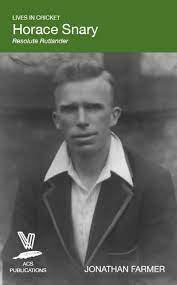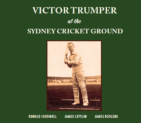Horace Snary: Resolute Rutlander
Martin Chandler |Published: 2023
Pages: 240
Author: Farmer, Jonathan
Publisher: ACS
Rating: 3.5 stars

In common with a goodly number of the cricketers whose lives have featured in the ACS Lives in Cricket series Leicestershire bowler Horace Snary is a long way from being a household name, and although his name rang a bell with me somewhere I have to confess to having had to quickly look him up when I first heard that this book was being published.
I soon learned that Snary has a place in the record books which will remain his in perpetuity, that being the title of the most parsimonious bowler in English cricket in the 20th century, his conceding runs at a rate of just 1.72 per over. He also took more than 400 First Class wickets, at a cost of just over 24 runs each, but despite being tipped by the Gloucestershire left arm spinner Charlie Parker as a candidate for Douglas Jardine’s 1932/33 Ashes party there is little likelihood that Snary was ever considered for higher honours.
The story of Horace Snary begins, as do so many biographies and autobiographies these days, with an initial chapter highlighting a particular incident from the subject’s life. In Snary’s case it might have been the occasion when, promoted from his usual ten or eleven, he opened the batting for his county against the 1932 Indian tourists and carried his bat for 124, his only century and indeed the only time he passed 50 in an innings.
But for Snary the opening chapter is an altogether grimmer battle, and tells the story of his being gassed during the Cambrai offensive on the Western Front in 1917. Snary’s lungs were permanently damaged, but despite a bout of double pneumonia threatening his life soon afterwards he survived to enjoy a career in cricket that lasted from 1921 to 1932.
First time author Jonathan Farmer was fortunate in that he had the full co-operation in writing the book of Snary’s only daughter, and was given full access to family records. The background material that forms the basis of the early part of the book therefore holds much more of interest than it would have if it had been written purely on the basis of public archives.
In terms of his Leicestershire career Snary made his debut in 1921, and four years later had appeared in a total of just six First Class matches with but a single wicket to show for them. To his credit he stuck at it nonetheless and, the county doing likewise, in 1926 he started to establish himself. After that he spent six summers as, when fit, an automatic choice.
A large part of the book sets out to give the story of Snary’s career on, effectively, a match by match basis. This can lead to a somewhat monotonous account but, as I learnt very recently with a biography of Kent all-rounder Alan Dixon, if done well it can still be a good means of producing a cricketing biography. The key seems to be that the subject did not enjoy a stellar career and, perhaps more obviously, that there is no more efficient recipe for tedium than a writer who simply looks at Wisden and describes what he or she can read and see there.
The first point is, I believe, because with an international player the real desire is to read about a player’s great deeds, and any attempt to concentrate on the daily grind of the count circuit does not therefore appeal. When, on the other hand, that daily grind is the major part of the story then it assumes a central role and becomes eminently more readable.
It is also important that back in the 1930s journalists attend county matches, and wrote about them in the newspapers, thus adding a great deal to the basic picture that a Wisden report and the scorecard show. Thus Farmer is able to weave into his narrative incidents such as a serious fire in a stand at Leicestershire’s old Aylestone Road ground, lightning striking a telegraph pole near a score box and unseating a scorer, as well as more light hearted incidents such as an occasion when a ball ran up the leg of Snary’s trousers, something I still find it difficult to imagine.
Snary’s decline was swift in 1933 and although he remained on the staff for the 1934 summer he did not play again and was released in 1935, just short of what would have been a well deserved benefit. The chapter dealing with those two summers, and the injuries that marred them, is an interesting one, and the following one probably the best in the book.
One of the difficulties that historians have with Snary is that beyond the fact that he generally bowled at something between slow and medium there is little unanimity about what type of bowler he actually was, be that finger spinner, wrist spinner, seamer or a combination of all three. The Style is the Man takes a long look at that question and answers it as comprehensively as is ever now going to be possible.
It is in the closing two chapters of the book where Snary’s daughter’s recollection of her father are also of great assistance to Farmer, enabling him with some authority to describe the personality of his subject. Snary was certainly an interesting man. Inevitably and understandably he was, like so many of his generation, scarred by his wartime experiences. He was a firm socialist from a working class background, yet he built a modest agricultural business and acquired a property portfolio so cannot have been entirely averse to capitalism.
As writing and researching debuts go Farmer’s is an auspicious one, and I sincerely hope this will not be his only contribution to the ACS Lives in Cricket series, and indeed he could do much worse for his next project than dig out his research for Snary again and take a long look at his teammate George Geary, a man who certainly merits a biography.






Leave a comment